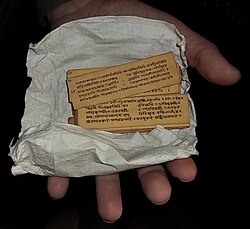Gunamala
Gunamala (Assamese: গুণমালা) is a scripture written by Sankardev within one night at the request of Koch king Nara Narayan in 1552.[1][2] It is an abridged version (handbook) of Bhagavata Purana capturing in racy, rhyming and sonorous verses. The poet recounts many incidents from Lord Krishna's life making them easy to remember in this book.[1]

Background[edit]
One day, King Naranarayan held some debates in his court between the Pandits and Sankardev. King Naranarayan once asked the court poets to give him, in one day, a condensed version of the entire ten cantos of the Bhagawat Purana. When all Pundits said it was not possible to do so in such a short time, Sankardev took up the challenge and accomplished the feat in one night.
After he had condensed the substance of the ten chapters of the Bhagawat Purana into a small booklet, he put it into a small wooden box. Then he painted the box with hengul-haital (yellow and red) an elephant squeezed inside a circle. He called it Bhurukaat Haathi- meaning an elephant squeezed in the Lime-pot (in Assamese: হাতী মাৰি ভুৰুকাত ভৰোৱা)! The pleased King Naranarayana honoured Sankardev.
Translation[edit]
In 1923, Benudhar Rajkhowa translated this book for the first time into English subtitled as Garland of Praises in verse.[3]
Again the English translation of this book in prose subtitled as Garland of Virtues was released on 7 April 2013. The translation has been done by Dr. Sanjib Kumar Borkakoti, who has translated Sankardev's Borgeets and Madhavdev's Namghosha a few years back.[4]
In 2010, Devi Prasad Bagrodia translated this book into Hindi and published keeping the same name Gunamala in both book as well as audio CD form.[5]
Usage[edit]
This book is greatly revered by the followers of Eka Sharana Nama Dharma, who keep it at the Guru asana (altar) in the congregational prayer-house called Namghar as the symbol of God.[4]
See also[edit]
References[edit]
- ^ a b "Gunamala". atributetosankaradeva. 16 April 2008. Retrieved 26 May 2013.
- ^ Neg Maheswar (1980). Early History of the Vaiṣṇava Faith and Movement in Assam: Śaṅkaradeva and His Times. Motilal Banarsidass. p. 182. ISBN 978-81-208-0007-6.
- ^ Sankaradeva; Benudhar Rajkhowa (1923). Gunamala. Assam Commercial.
- ^ a b "English translation of Gunamâlâ released". Assam Times. 8 April 2013. Retrieved 26 May 2013.
- ^ "The Assam Tribune Online". www.assamtribune.com. Archived from the original on 21 May 2014.
